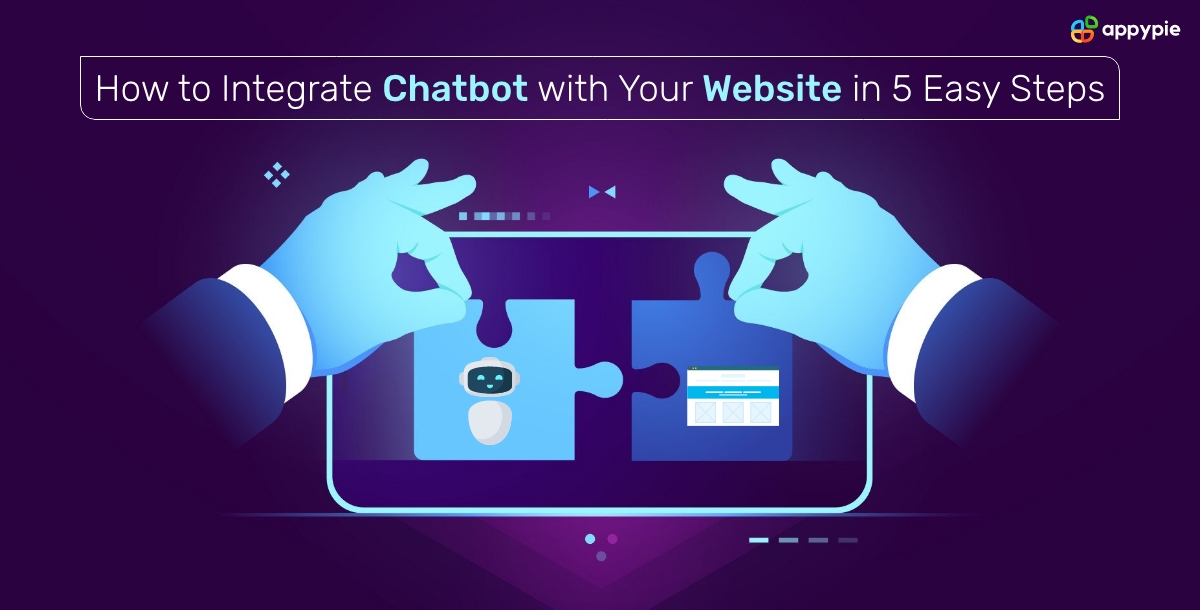How to Integrate Chatbot with Your Website in 5 Easy Steps

Dive into the world of seamless customer support and enhanced user interaction with our concise guide on integrating a chatbot into your website. Discover how in just 5 straightforward steps, Appy Pie's no-code platform can revolutionize your site's interactivity, ensuring your business stands out. Perfect for those looking to offer round-the-clock assistance and improve engagement without the technical hassle.
How to Integrate Chatbot with Your Website with Appy Pie
Integrating a chatbot for your website can dramatically improve user engagement and offer instant support to your visitors. Appy Pie, a premier no-code development platform, offers a streamlined approach for adding a chatbot to your website, ensuring that your site stands out with enhanced interactivity and support. Follow this step-by-step guide on how to integrate a chatbot in your website with Appy Pie, incorporating key phrases organically throughout the explanation.
Step 1: Create Your Chatbot
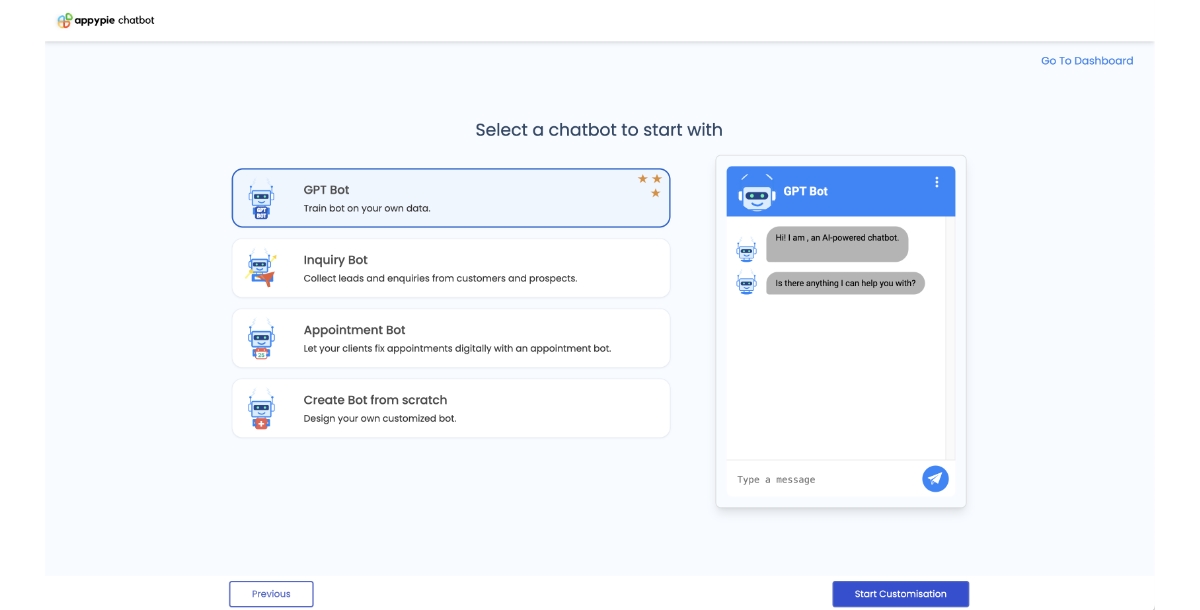
- Enter your chatbot's desired name: Start by naming your chatbot, giving it a personality that aligns with your brand.
- Select a chatbot as per your need: Whether you're looking for the best AI chatbot for your website or a simple query-resolving bot, Appy Pie has options to cater to all requirements.
- Choose the option to create an account: if you're a new user or login with your existing credentials. This initial setup is crucial for customizing and deploying the best website chatbot.
Step 2: Configure and Train Your Chatbot

- Upload Training Material: In the 'Configure' section, enhance your chatbot's capabilities by uploading PDFs, doc files, or website URLs. This step is essential for creating a chatbot for the website that can accurately respond to user inquiries.
- Save and Train: With a click, enhance your chatbot’s knowledge base, preparing it to deliver precise answers to FAQs and specific queries, embodying the best AI chatbot for website functionality.
Step 3: Customize Your Chatbot

- Select a Template: Appy Pie offers a variety of pre-built templates that suit different business needs and industries, simplifying the process of creating a chatbot for the website.
- Define Behavior: Establish how your chatbot will interact with users by setting up triggers and actions for various inputs. This customization is key to integrating a chatbot into your website.
- Design Conversational Flows: Map out the dialogue path, including greetings, questions, and responses, ensuring a seamless user experience indicative of the best website chatbot.
Step 4: Design Your Chatbot
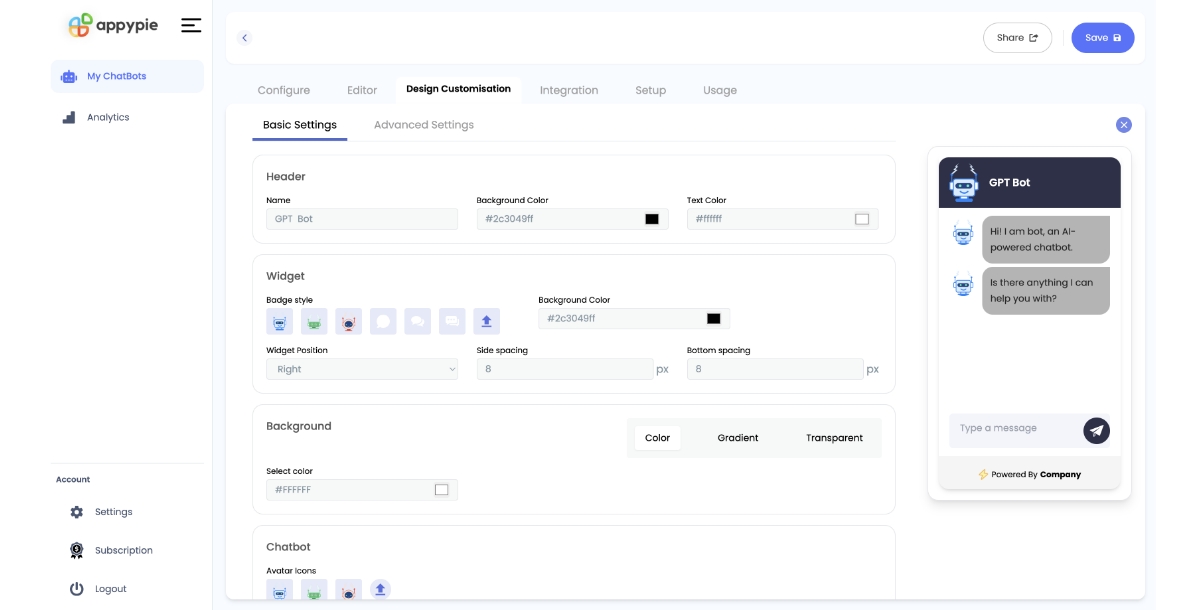
- Customize Appearance: Personalize Your Chatbot's Design: Leverage the intuitive drag-and-drop tool to modify how your chatbot appears, ensuring it aligns with your brand's visual aesthetic and complements the overall design of your site. This crucial adjustment helps your chatbot seamlessly blend into your digital presence.
- Test Your Bot: Before going live, test your chatbot to ensure conversations flow smoothly, making any necessary tweaks for optimal performance.
- Personalize the chat widget: Tailor settings like Name, Background Color, and Position to ensure your chatbot integrates well with your site, showcasing chatbot integration with a website at its finest.
Step 5: Deploy Your Chatbot
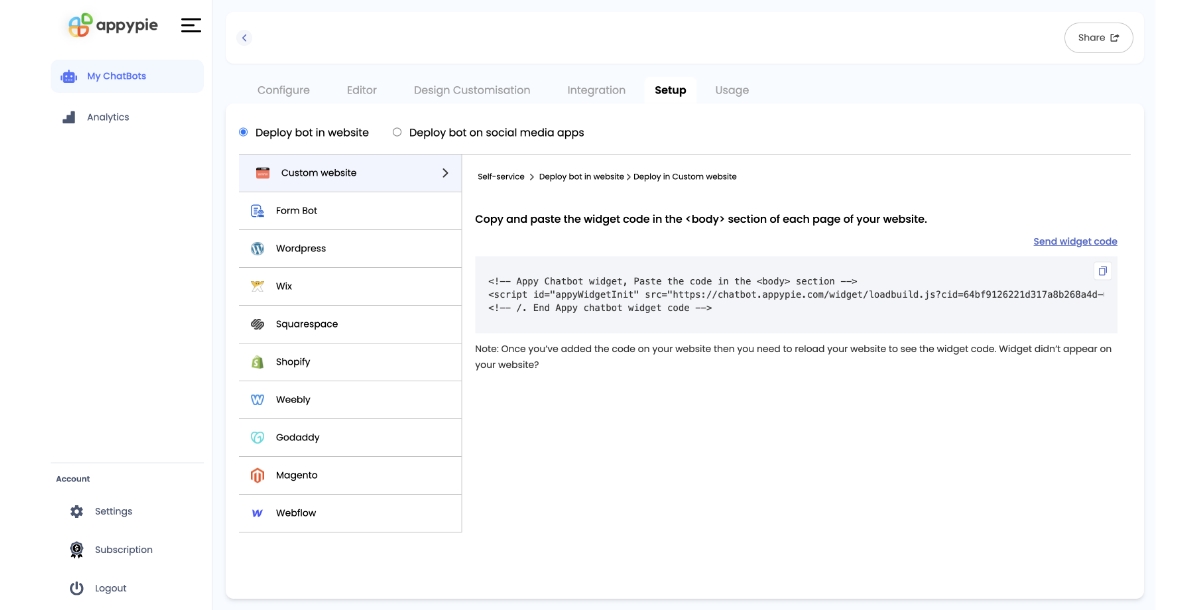
- Integrate with Your Website: To deploy, simply copy the widget code provided by Appy Pie and paste it into the section of your website's HTML, a straightforward solution for those pondering how to integrate a chatbot into your website.
- Go Live: After saving and publishing your changes, your chatbot is now live, offering real-time support and interaction to your site visitors.
Bonus Tip: Monitor and Optimize
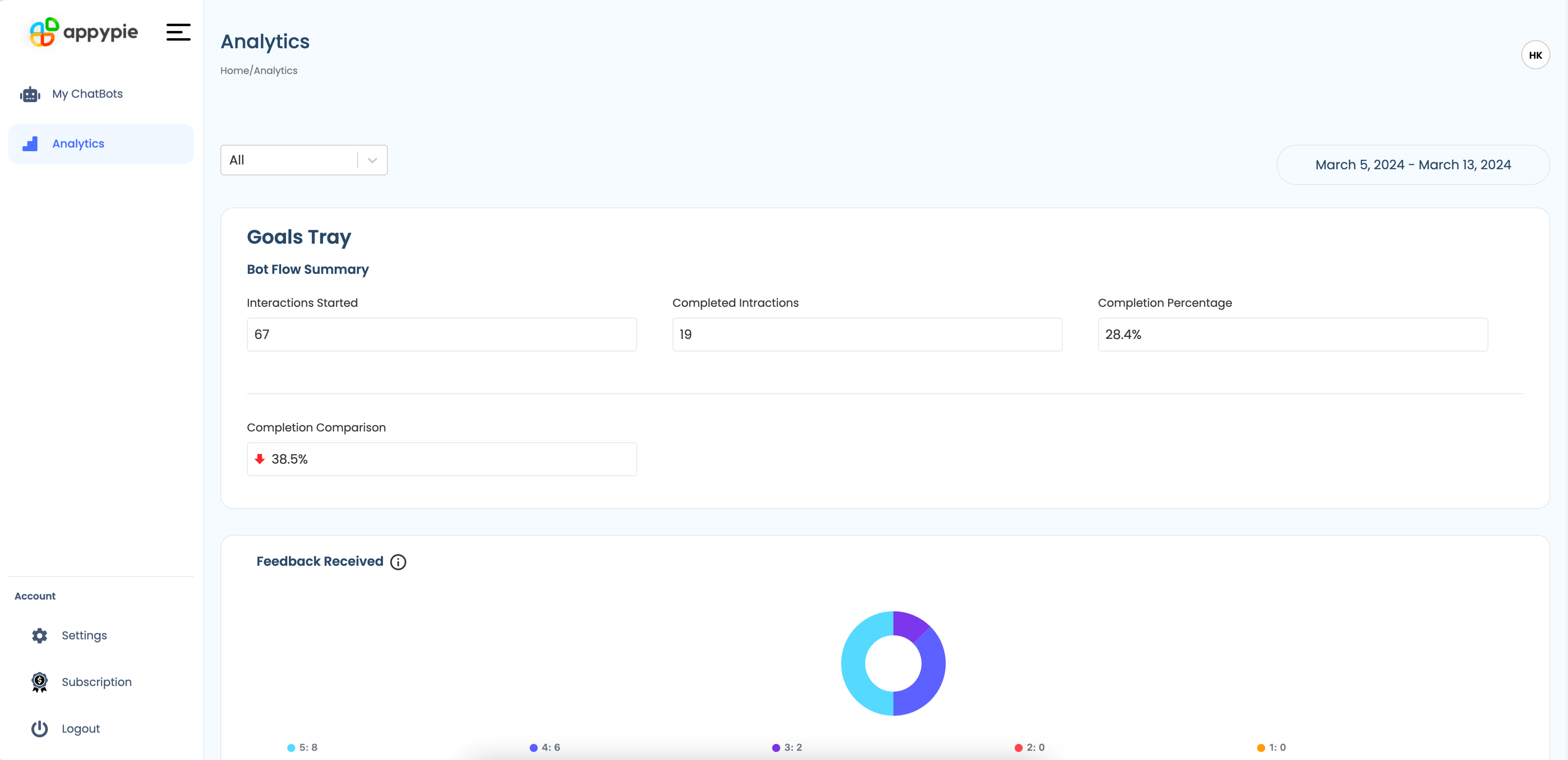
- Analyze Interactions: Leveraging Appy Pie’s analytics tools allows you to monitor how users interact with your chatbot, identifying both popular queries and potential drop-off points.
- Iterate and Improve: Use the insights gathered to refine your chatbot’s dialogues, responses, and user engagement strategies, ensuring your site features the best AI chatbot for website interaction and support.
By following these steps, you can effectively integrate a chatbot into your website, enhancing the user experience with immediate, interactive support. Appy Pie's platform simplifies the process, allowing businesses of all sizes to implement what could arguably be the best website chatbot solution tailored to their specific needs.
Importance of Integrating a Chatbot into Your Website
Integrating a chatbot into your website serves as a pivotal strategy for enhancing the overall user experience, driving engagement, and streamlining customer support operations. Here's a more detailed exploration of its importance:
- 24/7 Availability: Chatbots provide round-the-clock assistance, ensuring that users receive immediate responses to inquiries at any time of day, significantly improving user satisfaction by offering convenience and reliability.
- Efficient Query Handling: By automating responses to frequently asked questions, chatbots alleviate the workload on customer support teams, allowing them to focus on more complex queries. This efficiency boosts the overall productivity of the team.
- Cost-Effective: Deploying chatbots is a cost-effective solution for businesses. They reduce the need for a large customer service team, lowering operational costs and optimizing resource allocation.
- Personalized User Experiences: Chatbots can be programmed to deliver personalized experiences, making interactions more engaging. They can suggest products, services, or content based on the user's browsing behavior and past interactions.
- Valuable Insights Collection: Through interactions, chatbots collect valuable data on user preferences, behavior, and feedback. This data can inform business strategies, help in tailoring services or products to better meet customer needs, and enhance the overall user experience.
- Improving Conversion Rates: By guiding users through their journey, providing product recommendations, and answering their queries in real time, chatbots can significantly improve conversion rates. They play a crucial role in moving users along the sales funnel efficiently.
- Enhanced Engagement: Chatbots keep users engaged with interactive and conversational interfaces, making the browsing experience more enjoyable and interactive. This increased engagement can lead to higher retention rates and more return visits.
Strategies for Continuous Improvement in Chatbot Integration
Continuous improvement in chatbot integration is essential for ensuring that chatbots remain effective, efficient, and relevant to users' evolving needs. This ongoing process involves regularly evaluating and enhancing the chatbot's performance, user experience, and functionality. Here are strategies that can help in achieving continuous improvement in chatbot integration:
- A/B Testing
- Identify Variables: Start by identifying elements you want to test, such as different greeting messages, response formats, or the order of options presented to the user.
- Create Variants: Develop two versions (A and B) with only one variable changed between them. This isolates the impact of that variable on user behavior.
- Segment Your Audience: Divide your audience randomly to interact with either version A or B during the test period.
- Measure and Analyze: Determine the success criteria (e.g., completion rate of a specific task, user satisfaction score) and measure these across both groups. Use statistical analysis to determine which version performs better.
- Omnichannel Integration
- Identify Key Channels: Determine the most important channels your target audience uses and where a chatbot presence would be most beneficial.
- Integrate Chatbot Technology: Use APIs and integration tools to deploy your chatbot across these selected channels, ensuring it can access and share relevant data across platforms.
- Ensure Consistency: Harmonize the chatbot’s tone, responses, and available options across all channels to provide a unified brand experience.
- Test Cross-Channel Functionality: Regularly check that the chatbot performs well on all platforms, offering a seamless transition for users who switch between channels.
- Natural Language Processing Training
- Collect Diverse Data: Aggregate a wide variety of user inputs, including different phrasings, slang, and types of queries that your chatbot may encounter.
- Train with Context: Incorporate context into training sessions, ensuring the chatbot can understand the intent behind a user’s message, not just the message itself.
- Utilize Advanced NLP Tools: Leverage the latest NLP technologies and tools for training your chatbot, including those that specialize in understanding nuances and sentiment in user inputs.
- Continuous Learning: Set your chatbot to learn from interactions over time, adjusting its responses based on what works well and what doesn’t.
A/B testing, also known as split testing, involves comparing two versions of a chatbot’s script or interaction strategy to determine which performs better in achieving a desired outcome. This methodical approach allows for data-driven decisions that can significantly enhance the chatbot's effectiveness and user satisfaction.
Conducting A/B Testing
Applying Insights from A/B Testing
The insights gained from A/B testing should inform adjustments to the chatbot’s interaction strategy. By continually employing A/B testing on different elements of the chatbot experience, businesses can incrementally improve the chatbot’s performance and user satisfaction.
Omnichannel integration ensures that your chatbot provides a consistent and seamless user experience across various communication platforms, such as your website, mobile app, social media, and messaging services. This approach acknowledges that users may switch between channels while expecting continuity in their interactions.
Conducting Omnichannel Integration
Applying Insights from Omnichannel Integration
Utilize data from interactions across all platforms to refine your chatbot’s approach, ensuring it meets users' needs regardless of the channel. This might involve adjusting the chatbot’s conversational style to suit the norms of each platform or ensuring that the information provided is consistent and up-to-date across all channels.
Enhancing your chatbot’s NLP capabilities involves training it with a broader set of data and contexts to better understand and process user inputs. This results in more accurate responses and a more natural, conversational user experience.
Conducting Enhanced NLP Training
Applying Insights from Enhanced NLP Training
Use the insights gained from advanced NLP training to refine your chatbot’s understanding of user queries and its ability to engage in more meaningful conversations. This might involve tweaking response algorithms to better handle ambiguous queries or expanding the chatbot’s knowledge base to cover a wider range of topics.
Conclusion
Embrace the future of customer interaction with Appy Pie's chatbot integration, a simple yet powerful tool to revolutionize your website's engagement and support. In just five easy steps, you can unlock 24/7 assistance, personalized experiences, and valuable insights, ensuring your business not only keeps pace but leads in the digital age. Begin your journey towards seamless customer support and enhanced user interaction today, and watch as your website transforms into a dynamic, interactive hub that captivates and retains visitors like never before.
Related Articles
- Top 17 Best Slack Alternatives & Competitors for 2023
- How to Create an Amazing LinkedIn Banner
- How to Prepare for a Customer Service Interview- Questions & Answers
- BMW Logo: History, Symbol, Meaning & Evolution
- How to Make a Chatbot From Scratch?
- A Comprehensive Guide To Customer Profiles With Examples And Free Templates
- Beyond the Notch: Exploring iPhone 15’s Dynamic Feature
- Doritos Logo: A Glorious History of Little Bits of Gold
- How to Create & Share a Dropbox Direct Download Link
- OneNote Tutorial: Everything You Need to Know About Microsoft OneNote
